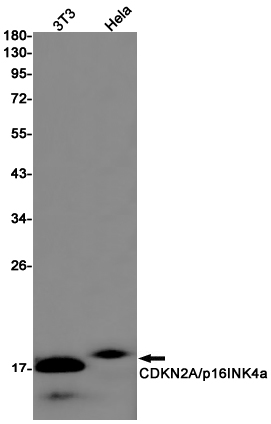
| WB | 咨询技术 | Human,Mouse,Rat |
| IF | 1/20 | Human,Mouse,Rat |
| IHC | 咨询技术 | Human,Mouse,Rat |
| ICC | 技术咨询 | Human,Mouse,Rat |
| FCM | 咨询技术 | Human,Mouse,Rat |
| Elisa | 咨询技术 | Human,Mouse,Rat |
| Aliases | CDKN2A; CDKN2; MTS1; Cyclin-dependent kinase inhibitor 2A; isoforms 1/2/3; Cyclin-dependent kinase 4 inhibitor A; CDK4I; Multiple tumor suppressor 1; MTS-1; p16-INK4a; p16-INK4; p16INK4A |
| Entrez GeneID | 1029 |
| WB Predicted band size | Calculated MW: 17 kDa; Observed MW: 17 kDa |
| Host/Isotype | Rabbit IgG |
| Antibody Type | Primary antibody |
| Storage | Store at 4°C short term. Aliquot and store at -20°C long term. Avoid freeze/thaw cycles. |
| Species Reactivity | Human,Mouse |
| Immunogen | Recombinant protein of human CDKN2A/p16INK4a |
| Formulation | Purified antibody in TBS with 0.05% sodium azide,0.05%BSA and 50% glycerol. |
+ +
以下是关于CDKN2A/p16INK4a抗体的3篇参考文献及其摘要概括:
1. **文献名称**:*"p16INK4a expression correlates with survival in melanoma: A multi-institutional study using tissue microarrays"*
**作者**:Straume O, Smeds J, Kumar R, et al.
**摘要**:该研究通过免疫组化技术分析p16INK4a蛋白在黑色素瘤组织中的表达,验证了其抗体的特异性,并发现p16INK4a的低表达与患者生存率降低显著相关。
2. **文献名称**:*"Validation of p16INK4a as a biomarker of senescence in human cells"*
**作者**:Krishnamurthy J, Torrice C, Ramsey MR, et al.
**摘要**:本文系统验证了p16INK4a抗体在检测细胞衰老中的可靠性,证明其在不同组织类型中可作为衰老相关β-半乳糖苷酶的有效替代标志物。
3. **文献名称**:*"Comparative analysis of commercial antibodies for the detection of p16INK4a in formalin-fixed paraffin-embedded tissues"*
**作者**:Matsuda Y, Hagio M, Ishiwata T.
**摘要**:研究比较了多种市售p16INK4a抗体的性能,发现克隆号E6H4的抗体在福尔马林固定石蜡包埋组织中具有最佳灵敏度和特异性,适用于宫颈癌前病变诊断。
4. **文献名称**:*"CDKN2A/p16INK4a mutations and prognosis in pancreatic cancer: A meta-analysis"*
**作者**:Ghosh S, Soroka A, Tang LH, et al.
**摘要**:通过荟萃分析探讨CDKN2A/p16INK4a蛋白表达缺失与胰腺癌预后的关联,强调了标准化抗体检测方法对临床结果一致性的重要性。
The CDKN2A/p16INK4a antibody is a crucial tool in cancer research and diagnostics, targeting the p16INK4a protein encoded by the CDKN2A gene. This tumor suppressor protein regulates the cell cycle by inhibiting cyclin-dependent kinases (CDK4/6), thereby preventing retinoblastoma (Rb) protein phosphorylation and blocking G1-to-S phase progression. Loss of p16INK4a function, through gene deletion, mutation, or epigenetic silencing, is a hallmark of various cancers, including melanoma, pancreatic, and lung carcinomas. Conversely, p16 overexpression is often observed in premalignant lesions or senescence, serving as a biomarker for cellular stress or oncogenic signaling.
In diagnostic pathology, p16 immunohistochemistry (IHC) is widely used as a surrogate marker for high-risk human papillomavirus (HPV) infection in cervical and oropharyngeal cancers, where viral E7 oncoprotein disrupts Rb function, leading to p16 upregulation. Researchers also employ p16 antibodies to study aging, senescence, and tumorigenesis in cell and animal models. Commercially available monoclonal antibodies (e.g., clone E6H4) are validated for IHC, western blotting, and flow cytometry, though interpretation requires context-specific caution, as p16 expression patterns vary across tissue types and disease states. Recent studies explore its role beyond cancer, including in neurodegenerative and cardiovascular diseases, underscoring its broad relevance in cellular homeostasis.
×